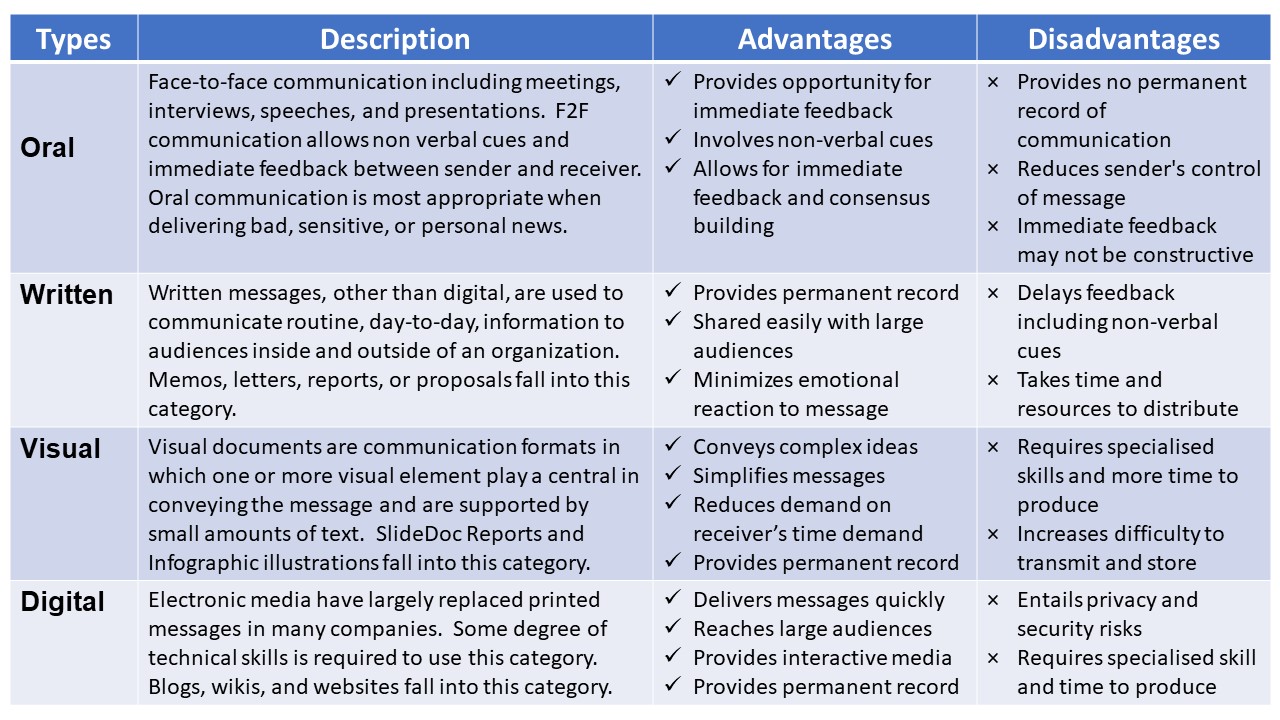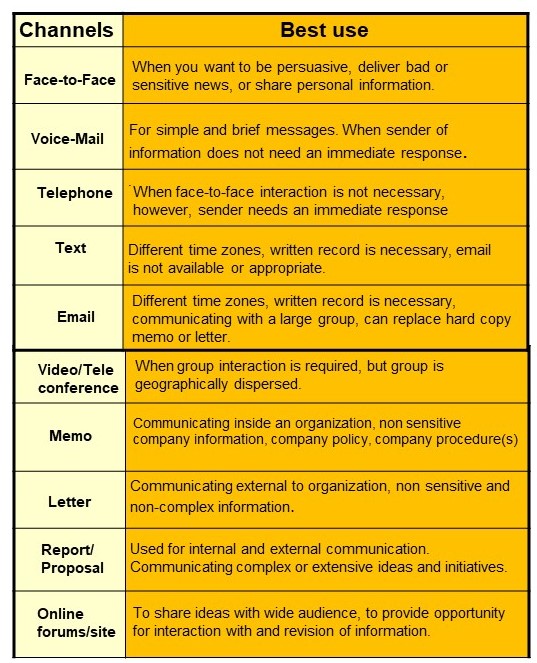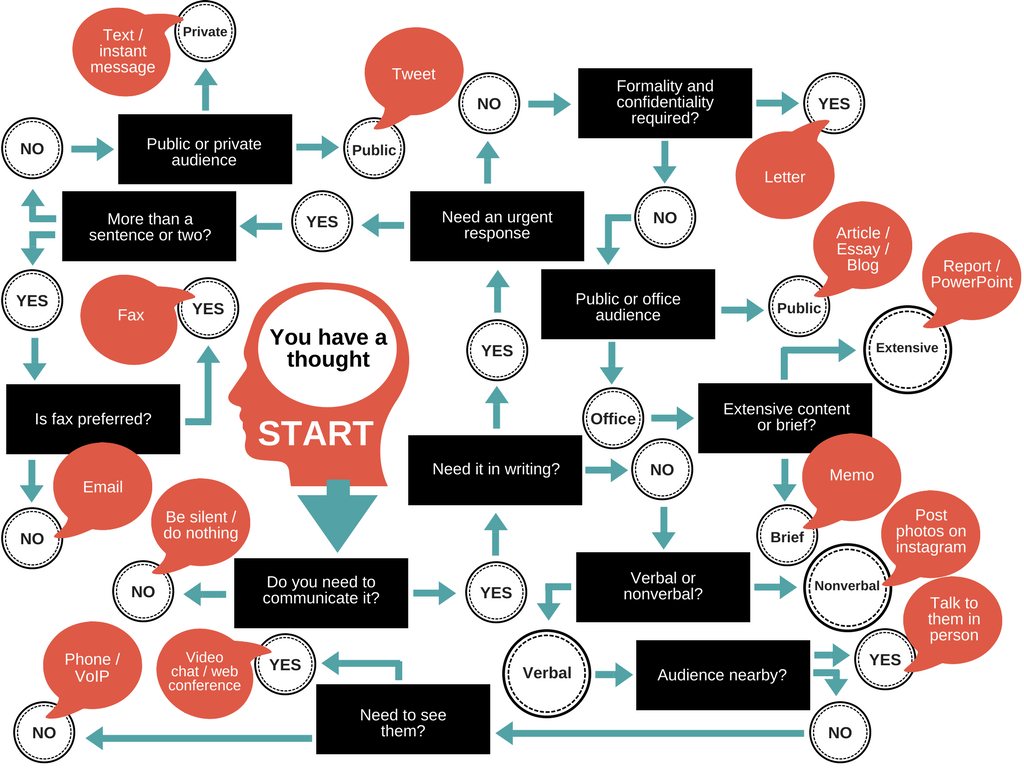Unit 23: Selecting Appropriate Channels
Learning Objectives
 After studying this unit, you will be able to distinguish between communication channels to determine which is most appropriate for particular situations.
After studying this unit, you will be able to distinguish between communication channels to determine which is most appropriate for particular situations.
Introduction
The medium or channel is the vehicle of transmission for a message. Generally, several communication channels could communicate a message, but choosing the most appropriate channel will depend on the audience, the message, and the purpose of communication. When communicating a message, choosing from traditional communication channels: memos, letters, face-to-face (F2F) meetings, and telephone calls; as well as digital media: emails, text messages, videoconferencing, blogs, and websites are all options. The business writer must have a clear understanding of the audience to ensure the channel of communication will effectively communicate the message.

Between traditional and rapid electronic media, we have more choice for communication channels than ever in human history. Each has its own unique advantages and disadvantages that make it appropriate or inappropriate for specific situations. Knowing those pros and cons, summarized in Table 23.1 below for a dozen of the most common verbal and written channels available, is necessary for being an effective communicator in the modern workplace. Choosing channels wisely can mean the difference between a message that is received and understood as intended (the goal of communication), and one that is lost in the noise or misunderstood in costly ways.
Selecting the Right Medium
Media can be categorized into four main types: oral, written, visual, and electronic.
Table 23.1: Types of Business Communication

There are other considerations when choosing the exact channel to send a message. When is a written memo preferable to an electronic one? When is a text message more appropriate than a telephone conversation? Understanding what situation, message, and receiver require which specific channel is the topic of our next section.
Message formality: The choice of channel is a non-verbal cue that affects style and tone. For example, a memo or letter is for formal in tone and format than is a text or IM message.
Media Limitation: Some channels are more appropriate for certain messages. For example, a report will convey a more complex message than a text message or discussing sensitive information is more appropriate in a face-to-face meeting rather than over a text message.
Urgency: Be mindful of people’s time. Messages that do not require immediate feedback can be communicated via email or voicemail rather than a f2f meeting or telephone conversation.
Cost: Some mediums are more costly than others. Cost is a non-verbal cue of importance. For example, communicating the importance of a change in company policy is more likely to be effective if shared in a f2f meeting than through a memo.
Choosing the wrong channel can result in a message that is less effective or even misunderstood.
Knowledge Check
The Spectrum of Common Workplace Communication Channels
Choosing the correct communication channel on the spectrum of options using the criteria above involves a decision-making process based on the purposes of the communication, as discussed earlier in this chapter. Factors to consider include convenience for both the sender and receiver, timeliness, and cost in terms of both time and money. Table 23.2 and the video that follows provides information on what medium is best used in what situation.
Table 23.2: Channel Selection Criteria
Knowledge Check: View the following video and respond to the questions presented.
Example: When to Select the Email Channel
When choosing to send an email, for instance, you:
- Begin with the thought you need to communicate
- Decide that it must be in writing for future reference rather than spoken
- Consider that it would be more convenient if it arrived cheaply the instant you finished writing it and hit Send
- Want to give the recipient the opportunity to respond quickly or at least within the 24-hour norm
- Decide that it would be better to send your message by email rather than by other electronic channels such as text, instant message (because you have more to say than would fit in either of those formats), or fax because you know the recipient prefers email over fax, as do most people and all but a few professional fields.
All of these decisions may occur to you in the span of a second or so because they are largely habitual. Figure 23.2 charts out the decision-making process for selecting the most appropriate channel among the 10 given in Table 23.2 above.
Figure 23.2: Channel Selection Process Flow Chart
We will examine the uses, misuses, conventions, and implications of these channels in the chapters ahead. For now, however, let’s appreciate that choosing the right channel at the outset of the writing process saves time—the time that you would otherwise spend correcting communication errors and doing damage control for having chosen the wrong one for the situation at hand. If you find yourself forced to meet someone in person to deal with the damage wrought by toxic email exchange before moving forward, just think how you would be into the next steps if you had skipped the email war and met in person to deal with the situation like adults in the first place.
References
Bovee, C.L., Thill, J. V., & Scribner J. A. (2016) Business communication essentials (4th ed.). Don Mills, ON: Pearson Canada Inc..
Guffey, M., Loewry, D., & Griffin, E. (2019). Business communication: Process and product (6th ed.). Toronto, ON: Nelson Education. Retrieved from http://www.cengage.com/cgi-wadsworth/course_products_wp.pl?fid=M20b&product_isbn_issn=9780176531393&template=NELSON
Royal Society for Public Health. (2017, May 19). Instagram ranked worst for young people’s mental health. Retrieved from https://www.rsph.org.uk/about-us/news/instagram-ranked-worst-for-young-people-s-mental-health.html
The physical means by which an oral or written message is transmitted.



